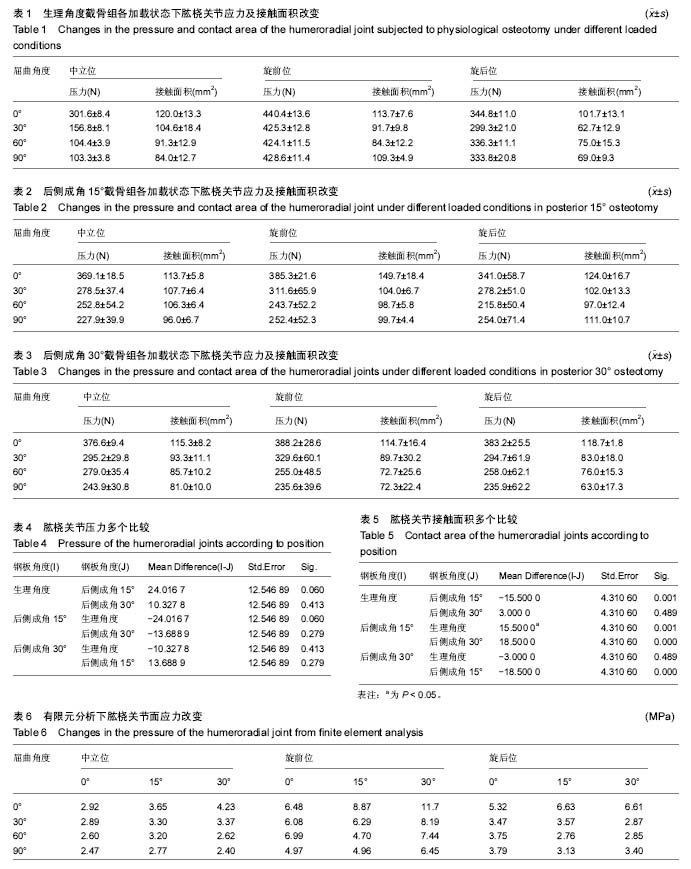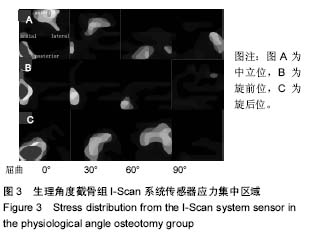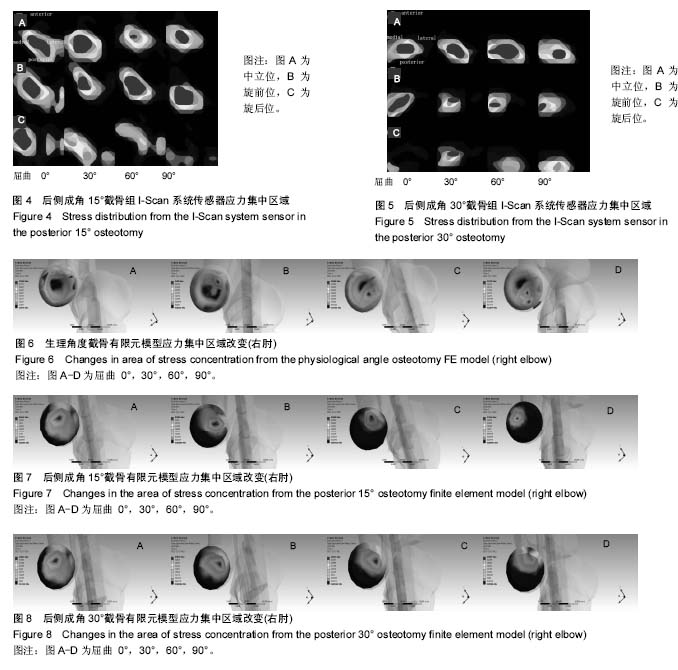中国组织工程研究 ›› 2017, Vol. 21 ›› Issue (35): 5679-5684.doi: 10.3969/j.issn.2095-4344.2017.35.017
• 骨与关节生物力学 bone and joint biomechanics • 上一篇 下一篇
有限元法及I-Scan测试系统分析尺骨成角截骨后肱桡关节的应力分布
何倩伟,魏 力,胡瀛宇,冯恩辉,邓万溪,周胜龙,陈海云
- 广东省中医院(广州中医药大学第二附属医院),广东省广州市 510120
Stress distribution on the humeroradial joint after ulnar osteotomy based on finite element analysis and I-Scan Stress Distribution Test system
He Qian-wei, Wei Li, Hu Ying-yu, Feng En-hui, Deng Wan-xi, Zhou Sheng-long, Chen Hai-yun
- Guangdong Provincial Hospital of Chinese Medicine (Second Affiliated Hospital, Guangzhou University of Chinese Medicine), Guangzhou 510120, Guangdong Province, China
摘要:
文章快速阅读:
.jpg)
文题释义:
孟氏骨折的发生机制:尽管目前关于孟氏骨折发生的机制已有详细研究,但仍难以确定尺骨骨折在先还是桡骨头脱位在先,然而不可否认的是尺骨稳定性对肱桡关节稳定起着重要作用。孟氏骨折以Ⅰ型、Ⅲ型多见,两者占孟氏骨折总发生率80%以上,主要表现为桡骨头向前侧、外侧脱位。
尺骨成角截骨:儿童孟氏骨折治疗的手术方式,对恢复肘关节正常解剖关系及功能,增加肘关节稳定和防止晚期桡神经损伤起到了积极的治疗作用。
摘要
背景:尺骨成角截骨矫形是治疗小儿孟氏骨折的首选手术方式,但仍然缺乏足够的生物力学证据证实其有效性及安全性。
目的:采用I-Scan测试系统以及有限元法分析尺骨成角截骨后肱桡关节的应力分布,为确定尺骨成角截骨角度及阐明成角截骨机制提供实验依据。
方法:采用9个肘关节标本,分别作生理角度截骨、后侧成角15°以及30°截骨,在中立位、旋前位以及旋后位情况下分别进行0°到90°加载,利用I-Scan传感器获得肱桡关节应力分布及受力面积改变。选取1个标本进行CT三维扫描,并以ANSYS建立由皮质骨组成的有限元模型,加载与I-Scan相同的工况。
结果与结论:①I-Scan测试显示,成角截骨后肘关节伸直时应力集中区在肱桡关节内侧,随着肘关节屈曲角度增加,应力集中区转移至后侧,肱桡关节应力及接触面积减少;后侧成角截骨组比生理角度组肱桡关节应力增加,接触面积减少;应力集中区域的转移,背离孟氏骨折多发的前侧及外侧,能减少桡骨头再脱位的发生,且在应力集中区转移方面分析,后侧成角30°截骨组优势可能大于后侧成角15°截骨;成角截骨后可能增加肱桡关节骨性关节炎风险,其中以后侧成角30°截骨更为明显;②有限元分析显示,后侧成角15°以及30°截骨组肱桡关节应力集中在内后侧;但后侧成角15°以及30°截骨组肱桡关节面压力增加;③综上,尺骨后侧成角30°截骨在防止肱桡关节再脱位上优于后侧成角15°截骨,但是可能增加肱桡关节退行性病变的发生。
中国组织工程研究杂志出版内容重点:人工关节;骨植入物;脊柱;骨折;内固定;数字化骨科;组织工程
ORCID: 0000-0003-1467-9475(何倩伟)
中图分类号:



.jpg)
.jpg)